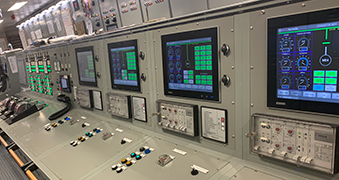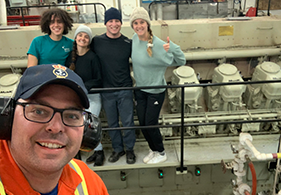Ashley Arroyo
September 28, 2022
Despite already having spent two weeks aboard the Louis S. St-Laurent, many of us on the science team have never been down to the engine room to see how the ship is powered! In between stations, a few of us on the night shift jumped on the opportunity to receive a tour of the engine room from Phil Rideout! Before we made the journey down to see the inner workings of the ship, we were warned that we would need earplugs, as it gets super loud down there. With earplugs in, the four of us (Nicolas, Annabel, Nimrod, and I) journeyed down several steep staircases and arrived in the control room of the engine room, where we met up with Phil. From there, Phil gave us the grand tour.
Despite its name, the “engine room” is made up of many rooms and extends from the hull of the ship through the ship’s smoke stacks! In case of an emergency (i.e., a fire or flood), it is important to have two escape routes in each room of the engine room, which were always pointed out to us. The Louis has 5 huge engines which can each produce up to 5MW of power; Phil noted that the combined power produced by the engines could power a small town! However, the ship typically runs on 2-3 of the engines, while the remaining engines are occasionally used if the ship is breaking through thick sea ice. We were also able to learn about the ship’s steering system, which is the largest steering gear on a ship in the world! There is also an emergency steering system located in the engine room, in the case that the primary steering (used by the folks on the bridge) is lost. They also have a rudder angle indicator, which shows the direction that the ship is steering in measured in degrees. Phil showed us around other parts of the engine room including the welding shop, the workshop, the 2 large boilers, the garbage incinerator, the water evaporator, and many more! The engine room has around 20 crew members that rotate around the clock to ensure that the Louis is always operating smoothly. Nearing the end of the tour, we asked Phil if we could see where the bubblers are. The bubblers can be used during some CTD casts to ensure that surrounding sea ice does not come close to the wire that holds the rosette. In the case that ice is getting close to the wire, the bubblers are turned on, and essentially push the sea ice away from the wire. Phil warned us that the steps were “steep,” and to be super careful. We ended up climbing down about a 30-foot ladder down into the bubbler room, where we learned about how the bubblers work.
It was very interesting to see and learn about how the ship is powered in the engine room! As to our whereabouts in the Arctic Ocean, the Louis is now sailing south on the 150°W longitude line heading to a mooring recovery/deployment site. More updates to come!


